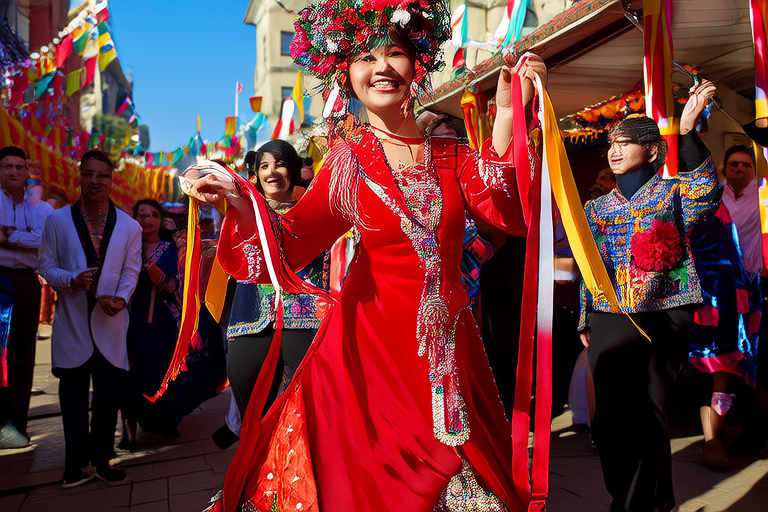Festivals of the World: Celebrating Cultural Customs Together

Festivals of the World: Celebrating Cultural Customs Together
Introduction
Festivals are vibrant expressions of human creativity and cultural identity. They serve as a means for people to celebrate their heritage, traditions, and unity. Across the globe, festivals are marked by colorful parades, elaborate costumes, and communal feasts, all of which reflect the unique customs and beliefs of the people who celebrate them. These events not only strengthen bonds within communities but also provide a platform for cultural exchange and understanding.
The significance of festivals extends beyond mere celebration; they are crucial in fostering cross-cultural appreciation. By participating in or observing festivals from different parts of the world, we gain insights into diverse ways of life, thereby enriching our own perspectives and deepening our respect for others.
Global Festivals Overview
Festivals can be broadly categorized into religious, secular, and seasonal celebrations. Religious festivals often commemorate significant events in the lives of deities or saints, while secular festivals may honor historical figures, national achievements, or cultural milestones. Seasonal festivals, on the other hand, are tied to the changing of the seasons and agricultural cycles.
From the vibrant Holi in India to the serene Lantern Festival in China, from the joyous Carnival in Brazil to the solemn Day of the Dead in Mexico, festivals span every corner of the globe. In Africa, the Yam Festival in Nigeria celebrates the harvest of yams, a staple crop, while in Europe, the Oktoberfest in Germany showcases the country’s love for beer and camaraderie. In Oceania, the Matariki festival in New Zealand marks the Māori New Year with star-gazing ceremonies and traditional crafts.
In-Depth Exploration of Key Festivals
Holi: The Festival of Colors in India
Originating in ancient India, Holi celebrates the triumph of good over evil and the arrival of spring. Participants throw colored powders and water at each other, symbolizing the breaking down of social barriers and the renewal of relationships. Rituals include bonfires, singing, and dancing. The festival fosters community bonding and promotes cross-cultural appreciation by inviting tourists and locals alike to join in the revelry.
Lantern Festival in China
The Lantern Festival marks the end of the Chinese New Year celebrations. People hang lanterns adorned with riddles in public spaces, and families gather for mooncake feasts. This festival emphasizes family unity and community harmony. It also serves as an opportunity for cultural exchange, with international visitors experiencing firsthand the beauty and traditions of this ancient celebration.
Carnival in Brazil
Carnival in Rio de Janeiro is renowned for its elaborate parades, samba dances, and flamboyant costumes. It began as a pre-Lenten celebration but has evolved into a showcase of Brazilian culture and artistry. Participants form samba schools that compete in grand parades, attracting millions of spectators. The festival brings together diverse communities and promotes cultural pride.
Day of the Dead in Mexico
The Day of the Dead honors deceased loved ones with altars decorated with marigolds, photos, and favorite foods. Families visit gravesites to clean and decorate them, ensuring that spirits are welcomed back to the living world. This festival reflects a deep connection between the living and the dead, promoting remembrance and continuity. It also invites visitors to experience the rich cultural heritage of Mexico.
Matariki in New Zealand
Matariki, the Māori New Year, celebrates the rising of the Pleiades star cluster. Traditionally, it marks the beginning of the new year and the start of the agricultural cycle. Today, it includes star-gazing ceremonies, traditional crafts, and educational programs. This festival strengthens Māori identity and promotes intercultural dialogue among New Zealanders.
Cultural Exchange and Tourism
International tourism plays a vital role in preserving and promoting local festivals. Visitors contribute to the economies of host communities and help sustain traditional practices. However, commercialization and globalization pose challenges. Mass tourism can lead to the commodification of cultural symbols and the erosion of authentic experiences. Striking a balance between economic benefits and cultural integrity is essential for the long-term sustainability of these events.
Conclusion
Festivals are powerful tools for preserving cultural identity and promoting unity. They offer a window into the rich tapestry of human experience and encourage mutual respect and understanding. By participating in or learning about festivals from different parts of the world, we can deepen our appreciation for the diversity of human culture and strengthen our global community.